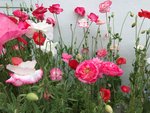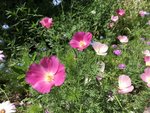

Researchers have spent an enormous amount of time and money proving what gardeners could have told them for free, instantly: gardening is good for our physical and mental health.
So, do certain plants get bonus points in the good-for-us-to-grow sweepstakes? You might think broccoli would qualify, but that’s because it’s better for us when eaten, not grown. My vote for the good-to-grow honors is poppies – all kinds of them. To borrow a phrase from Marie Kondo, of Tidying Up fame, poppies spark joy.
Last spring, I found seeds for pink California poppies, and they sparked joy all summer and into the fall. Now they’re getting ready to do it again. They are reputed to be annuals (plants that only live for one growing season), but a few lived through the winter. The rest dropped seeds that have sprouted and will start blooming again in a few weeks.
You have probably seen zillions of orange California poppies. A huge swath of them bloomed in the median of I-5 just north of Hawks Prairie last summer. You might also have seen them growing through the cracks in a sidewalk or blooming next to the ugly shrubs in front of a gas station. These poppies don’t need gardeners, but some gardeners may need them.
If you’ve had the luxury of a trip to Italy, you’ve also seen red poppies dotting wheat fields; these are the poppies that grow in the “fields of Flanders” in Belgium, where American soldiers who died in World War I are buried.
Those red poppies have since been coaxed into blooming in other colors. In the mid-19th century, the Reverend William Wilkes, the Vicar of a village called Shirley, near London, noticed “in a waste corner of my garden abutting on the fields a patch of the common wild field poppy, one solitary flower of which had a very narrow edge of white.” He managed to breed successive generations of seed from that single flower to create the many shades of pink, white, orange and peach now known as Shirley poppies.
Shirley poppies are also annuals that reseed freely. Some seed packets say not to cover the seeds when you plant them, but a very thin covering of soil seems to work more reliably. Sometimes it takes more than one try to get them to come up, but once they’re up, you’re in the Shirley poppy business for life. They reseed with an enthusiasm almost equal to California poppies.
The poppies whose seeds we use on bagels and in muffins and cakes are also annuals. (They are also the poppies from which opium is derived.) If you grow them, collecting the seedpods before they have a chance to scatter is a good idea; they reseed so freely that they’re hard to get rid of once they get established. Although their flower colors are often muddy and uninteresting, their ingenious and dramatic seed pods are often used in dried arrangements.
Then there are the big, glorious perennial poppies, known as Oriental poppies, but really from the Middle East. They grow big, spreading clumps and typically bloom in June. Vivid orange is the most common color, but since plant breeders are always up to something, these poppies are now available in red, purple and probably other colors too. They take up a lot of space but can be cut back to the ground after they’ve bloomed to make room for neighboring plants.
There is also a heavenly blue Himalayan poppy. In my garden, it had just come into bloom when it got smashed by a soccer ball, and then failed when transplanted to a safer spot. This one is hard to find locally, except in the Rhododendron Species Garden in Federal Way, where it will be celebrated with a festival on May 20.
Missing from this list so far are some poppies I’ve never grown: Icelandic poppies are delicately gorgeous, often grown for cut flowers, and bloom mostly in late spring. Celandine poppies are yellow, a short-lived woodsy perennial that blooms in the spring and intermittently during the summer. It also reseeds freely.
It’s hard to say what makes poppies such a joyous sight. Is it the soft, wrinkly way they emerge from their buds, like newborn kittens? Is it their breathtaking colors or the texture of their petals? Or is there a special kind of magic that passes between a poppy and a pair of human eyes?
Whatever it is, you won’t want to miss it, and early spring is the ideal poppy planting time.
Jill Severn writes from her home in Olympia, where she grows vegetables, flowers, and a small flock of chickens. She loves conversation among gardeners. Start one by emailing her at jill@theJOLTnews.com
2 comments on this item Please log in to comment by clicking here
Drutty
I totally agree that poppies are happiness personified! Tall and waving in the breeze, they are like fairy flowers! Looking forward to them again.
Friday, March 24, 2023 Report this
PegGerdes
Dreaming of poppies now! Another joyous feature is how they move in the slightest breeze. Thank you for this essay!
Saturday, March 25, 2023 Report this